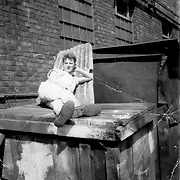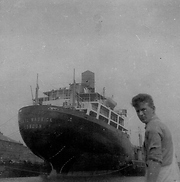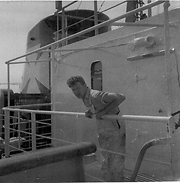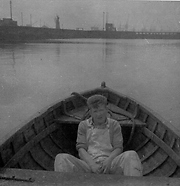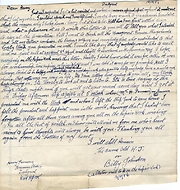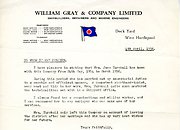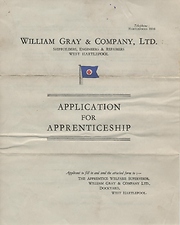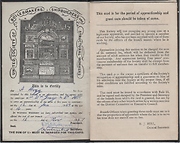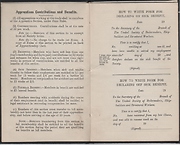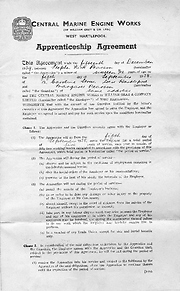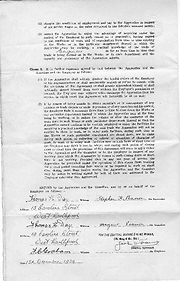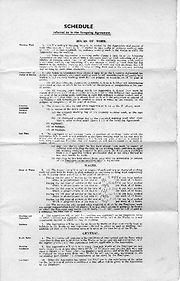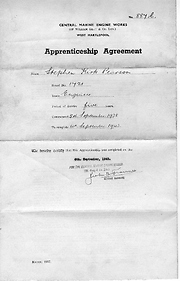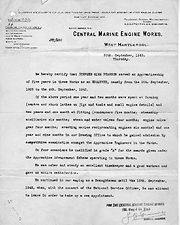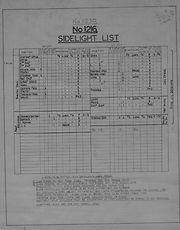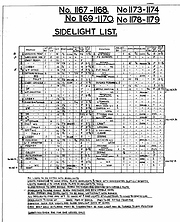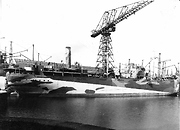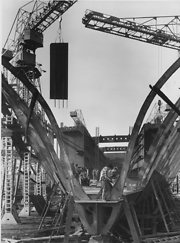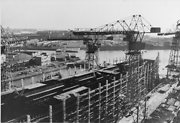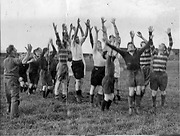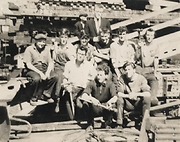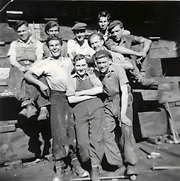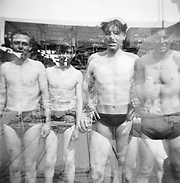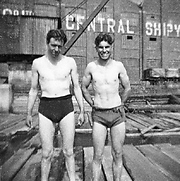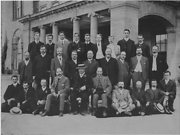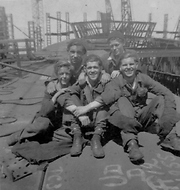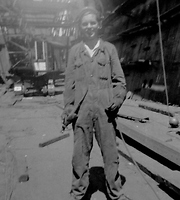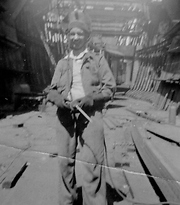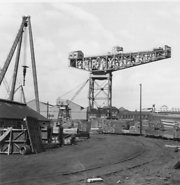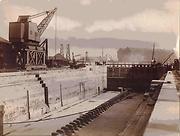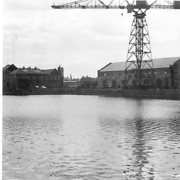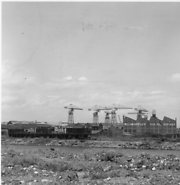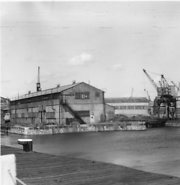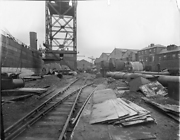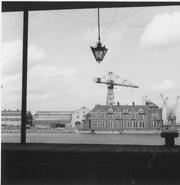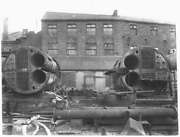 Hartlepool Sports & Leisure
Hartlepool Sports & Leisure
- Cinemas, Theatres & Dance Halls
- Musicians & Bands
- At the Seaside
- Parks & Gardens
- Caravans & Camping
- Sport
 Hartlepool Transport
Hartlepool Transport
- Airfields & Aircraft
- Railways
- Buses & Commercial Vehicles
- Cars & Motorbikes
- The Ferry
- Horse drawn vehicles
 A Potted History Of Hartlepool
A Potted History Of Hartlepool
- Unidentified images
- Sources of information
- Archaeology & Ancient History
- Local Government
- Printed Notices & Papers
- Aerial Photographs
- Events, Visitors & VIPs
 Hartlepool Trade & Industry
Hartlepool Trade & Industry
- Trade Fairs
- Local businesses
- Iron & Steel
- Shops & Shopping
- Fishing industry
- Farming & Rural Landscape
- Pubs, Clubs & Hotels
 Hartlepool Health & Education
Hartlepool Health & Education
- Schools & Colleges
- Hospitals & Workhouses
- Public Health & Utilities
- Ambulance Service
- Police Services
- Fire Services
 Hartlepool People
Hartlepool People
 Hartlepool Places
Hartlepool Places
 Hartlepool at War
Hartlepool at War
 Hartlepool Ships & Shipping
Hartlepool Ships & Shipping

William Gray & Co. 1874-1889
William Gray & Co. Ltd. 1889-1918
William Gray & Co. (1918) Ltd. 1919-1923
William Gray & Co. Ltd. 1923-1963
The early partnership with John Punshon Denton
William Gray settled in Hartlepool in 1843. He owned a successful drapery business, and had investments in several ships. In 1863he formed a partnership with local shipbuilder John Punshon Denton. The new firm was named Denton, Gray and Company. They intended to build iron ships, which were just starting to replace wooden-built vessels. They extended Denton’s yard at Middleton to include part of the former Richardson Brothers’ yard. Their first ship Dalhousie (later renamed the Sepia) was launched on 23rd January 1864.
In 1865Denton, Gray & Co joined with shipbuilders Richardson, Duck and Company of Stockton, and marine engine builders T. Richardson and Sons. The new partnership was called Richardson, Denton, Duck and Company. A slump in the market meant that this new firm only lasted until September 1866. After this all the firms went back to their original ownership and names.
The success of Denton, Gray and Co.
In 1867 Denton, Gray & Co launched the Lizzie English, which is thought to have been the first well-deck steamer. In the same year, they expanded into a disused shipyard which had belonged to Blumers. As orders increased the firm needed still more workspace and, in June 1868, they leased the vacant Pile, Spence yard. By summer of 1869, all the workforce had been transferred to the new yard, while the Middleton yards, including Blumers, were taken over by Withy, Alexander and Co. The move meant that Denton, Gray and Co. now had two dry-docks. This allowed them to increase their business in repairing and over-hauling ships as well as shipbuilding.
The end of the partnership
When William Gray and J.P. Denton first went into business together they had each put up an equal share of the money needed. They had agreed to divide the profits, with Denton taking 55% and Gray 45%. This was because Denton intended to take care of most of the running of the business, leaving Gray free to do other things. When Denton became ill in 1869 Gray had to take over more of the work, so they agreed to share the profits equally. Some legal problems were beginning to develop in the partnership, however.
Both of Denton’s sons worked for the firm, and he wanted them to become partners. Gray did not agree. He was willing to take on Denton’s older son, Richard, but he wanted his own eldest son, Matthew, as the other partner, as soon as he was old enough. There had been no legal documents drawn up when Gray and Denton went into partnership, since they had trusted that “a man’s word is his bond”. The two men could not reach an agreement and the matter was put in the hands of the courts. No decision had been made by the time of Denton’s death in 1871.
William Gray and Company
By 1874 the courts had still not reached a conclusion over who should be allowed to become a partner, and finally Richard Denton left the firm. It was now renamed as William Gray and Company. The first ship launched by the new firm was the Sexta in August 1874. In 1877 Matthew Gray, William’s older son, became a junior partner.
The new company was even more successful than the old one had been. In 1878 William Gray and Company launched eighteen ships. This earned them the “Blue Riband”, which was a prize for the most ships built in a year by any British shipyard. They won the same award in 1882, 1888, 1895, 1898 and 1900.
The Central Marine Engineering Works
In 1883 Gray leased a ten-acre site for a new works, which would build engines for his ships. At the time the only other marine engine works in the port was that of Thomas Richardson. Gray recruited Thomas Mudd, who had formerly worked at Richardson’s, to design and run the new firm, which he called the Central Marine Engine Works (CMEW). The new company gave employment to 1000 men. Their first engine was produced in 1885, and was fitted in the Enfield.
CMEW soon gained a reputation for the quality of its work. This was in a large part due to Thomas Mudd, who used many of his own ideas and designs in the engines. By 1894, when he was made a director of the company, CMEW engines were being made not just for Gray’s ships, but for shipyards all over the world.
Safety at sea
Conditions on board ship at the end of the 19th century were not very safe. Vessels were often dangerously overloaded with cargo. A Member of Parliament called Samuel Plimsoll campaigned to have a line drawn on the side of a ship, which would disappear underwater if the ship were too heavily loaded. William Gray was a member of the Parliamentary Committee which made the Plimsoll line law in 1876.
Gray was also involved in the development of a new design of ship, called the well-deck. Up until now, ships had been designed the same way regardless of whether they were powered by sail or steam. Cargo ships had holds (spaces to store the cargo), at the front and back. The engine needed for a steamship took up a lot of space at the back of the ship. This reduced the size of the rear cargo hold, and put the ship off balance. This was very dangerous in bad weather, as the ship could capsize. The well-deck design lowered the front cargo hold and raised the rear hold to be partly above deck level. This increased the amount of rear cargo storage space, and gave the ship better balance.
In 1884, Gray gave evidence before the Royal Commission on Loss of Life at Sea. He showed that the new well-deck design was far safer and less likely to capsize than other cargo ships. His arguments convinced the Commission, and a few years later an Act of Parliament was introduced, supporting the well-deck design.
Oil Tankers
On 16th June 1886, a Tyneside shipbuilding firm, Armstrong, Mitchell and Co. launched the world’s first oil tanker, the Gluckauf. Gray’s launched their own tanker, the Bakuin, on 17th June, and so missed the record by just one day.
At this time most of the world’s supply of oil came from the Standard Oil Company. The cheapest way to ship oil around the world was through the Suez Canal. This had been opened in 1869, and provided a short-cut between the Mediterranean and Red Seas. In 1892 the Suez Canal Company introduced new regulations which all ships had to meet before they could go through the canal. In May of the same year Gray’s launched the Murex, the first of six ships ordered by a London man named Marcus Samuel. These ships met the new regulations exactly. The ships belonging to Standard Oil did not. This allowed Samuel to win a share of the oil market away from Standard Oil, and was the beginning of the now-famous Shell Oil Company.
Keeping the work coming in
Gray’s yards were always kept busy with ship building, repairing and overhauling. William Gray encouraged business by offering credit to would-be ship owners. One of these was Marcus Samuel, founder of Shell Oil. The first of his ships, the Murex cost £47,000 to build in 1892, but at first Samuel only paid out £6,350. This kind of arrangement meant that William Gray held shares in about half of the ships his yard built. This was profitable for him, but also meant that people like Samuel were able to build ships they otherwise couldn’t afford.
Changes in the Company
Towards the end of the 19th century, demand was for bigger ships. This led to the opening, in 1887, of another Gray shipyard at the end of the Central Dock. On 1st January 1889 the firm became a private limited company. William Gray remained as chairman, with his sons Matthew and William, and his son-in-law George Henry Baines, as directors.
Matthew Gray died in 1896, followed two years later by both Sir William Gray, and Thomas Mudd. This left Sir William’s younger son, William Cresswell Gray, as Chairman of the company.
Extending the business
The new chairman, William Cresswell Gray, began a series of additions to the company. In 1898 he purchased Milton Forge and Engineering Company. This increased the number of marine engines, boilers, pumps and other steam driven machinery which C.M.E.W. could produce.
Also in1898, the company purchased the Malleable Iron Co Ltd and the Moor Steel Works, both in Stockton. These were combined with the West Hartlepool Steel and Iron Company, to form the South Durham Steel and Iron Co Ltd., providing materials to build Gray’s ships.
By 1900 two more berths for building ships had been added to the Central shipyard. Gray’s now had eleven berths, and employed 3000 men.
In 1913 Gray’s extended the lease on their shipyards. It had been due to expire in 1925, but would now last until 1950. At the same time, they leased some land on the banks of the River Tees near Greatham Creek. This was intended for a new shipyard, to be called Graythorpe. The plans had to be put on hold, however, when the First World War started in 1914. It was to be 1924 before the Graythorpe yard finally opened for business.
The effects of the First World War
The outbreak of the First World War brought a boom time to the shipyards. As well as their usual orders from commercial ship owners, Gray’s also built war ships and other vessels for the Admiralty. One of these was to have a very short career. The cargo ship War Crocus left the shipyard for the first time on the evening of 7th July 1918. By early the next morning she had reached Flamborough Head, where she was struck by a torpedo and sunk. Fortunately all her crew were saved.
In 1916 part of CMEW was set up as a production line to make shell cases for explosives. Almost all the workers at the “shell factory” were women. In 1917 the important part the yards played in the war effort was marked by a visit from King George V and Queen Mary.
William Gray & Co (1918) Ltd.
In 1918, Sir William Cresswell Gray joined with Lord Inchcape, Sir John Ellerman and F.C. Strick to form the EGIS Shipbuilding Co. This was based on the River Wear. The new firm was short-lived, however. Their first ship had not been completed before the EGIS Co. went out of business, and was merged with Gray’s to form William Gray and Company (1918) Ltd. Gray’s existed in this form until 1923, when it changed its name for the final time, back to William Gray & Co. Ltd.
The slump in shipbuilding after the war
When the First World War ended in 1918, the demand for new ships began to fall. Irvine’s Shipbuilders were unable to survive the slump, and launched their last ship in 1924. This left Gray’s as the only shipbuilders in the Hartlepools.
William Cresswell Gray died on 1st November 1924, and the firm was taken over by his son, also called William. Although the company was badly hit by the recession, they managed to keep going. In 1929 they launched their 1000th ship, the City of Dieppe.
By this time William Gray & Co. had two berths at Jackson Docks and two at Swainson Docks, five at the Central yard, four berths at the Wear yard and four at the Tees yard (although these were actually never used). The C.M.E.W. had made 774 engines, and other engineering jobs. The company employed 3500 workers.
In the early 1930s the economic depression got much worse. Gray’s shipyard on the River Wear was closed down in 1930, and the company built no ships at all during 1931 and 1933. Many local people were dependant on Gray’s for their living, and used to gather at the shipyard hoping for work. In order to stay in business, Gray's took on any jobs they could get. In 1934 they took an order from the London and North Eastern Railway Company to build a pair of paddle steamers; the Wingfield Castle and the Tattershall Castle. Although these were not the type of ships Gray’s normally built, it was the only order they had that year, and helped to keep the yard open. For many years afterwards the two paddle steamers provided a passenger ferry service across the River Humber. The Wingfield Castle finally retired from service in 1974, after carrying more than ten million passengers, and travelling over half a million miles backwards and forwards over the river. In 1986 she was bought by Hartlepool Borough Council, and returned to the town to be restored. She is now part of the Museum of Hartlepool, and is moored in almost exactly the place where she was first launched.
Shipbuilding during the Second World War
The Second World War began in September 1939. As before, the outbreak of war brought a huge boost to the shipping industry. Gray’s repaired and overhauled old ships, as well as building new ones. From the launch of the first of these ships the Empire Bay on the 18th of January 1940, to the final one, Empire Gower on the 18th of January 1946, ‘Gray’s’ built 73 ships. There were four types of ships built, ‘Collier’ class 9 ships, ‘Empire Malta’ class 10 ships, ‘Scandinavian‘ class 24 ships, & ‘Tramp’ class 30 ships. The ship with the shortest life was Empire Knoll which was completed in early February 1941 and. after loading coal for Lisbon at Hartlepool went ashore at Tynemouth on the 17th of February and. became a total wreck. The ship with the longest life was Empire Buttress, which by then being named Daring, was scrapped in 1976 at Split in Yugoslavia. The yards also built a number of ships under private contracts during these war years.
The aftermath of the war
The yard continued to be kept busy for some years after 1945, with orders from shipping firms who had lost their fleets in the war. In 1955, William Gray appointed his elder son, William Talbot Gray as joint managing director. He gave the other post to Stephen Furness, whose family had also been important local shipbuilders. Furness retired in 1958. By this time, British shipbuilding was once more struggling to survive.
During the 1950s Japan and Germany began to take over the market for shipbuilding and repairing. Their industries had been badly damaged during the war, but were now being rebuilt with the most up-to-date equipment. At the same time, British shipyards were suffering from industrial disputes and problems with their suppliers, which made them unreliable. In addition, ships were becoming much bigger, and the old yards did not have the space to build them.
The end of the Hartlepool shipyard
By the beginning of the 1960s, William Gray & Co. was unable to stay in business any longer. They launched their last ship, the Blanchland in 1961. They continued with some ship repair work for a while longer, but finally went into voluntary liquidation in December 1962, with the yards closing down completely in 1963. William Gray died in 1978, aged 82. His son, William Talbot Gray, was killed in a car accident in 1972.
The impact Gray’s shipyards had on the town
Gray’s shipyards were one of the largest employers in the Hartlepools for almost a century. C.M.E.W. was in existence for 80 years. With their closure, followed by the town’s other main industry, the steel works, Hartlepool fell into a period of poverty and high unemployment. This began to change in the early 1990s, when large areas of the town were redeveloped. The docks where Gray’s once built their ships have now become a marina, attracting small sailing vessels from all over the world.
Related items () :
 Aerial Photograph of West Hartlepool Dock System
Aerial Photograph of West Hartlepool Dock System
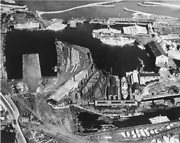 Donated by Hartlepool Museum Service
Donated by Hartlepool Museum ServicePart of the Shipbuilding collection
Aerial Photograph of West Hartlepool Dock System showing Gray's North yard in the foreground and remnants of the mothball fleet in the background.
More detail » Alpherat (1)
Alpherat (1)
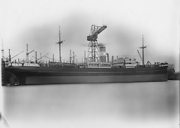 Donated by Hartlepool Museum Service
Donated by Hartlepool Museum ServicePart of the Shipbuilding collection
Dated 1928
The steamship Alpherat at Gray's Central Yard, Hartlepool.
More detail » Dazzle paint scheme (1)
Dazzle paint scheme (1)
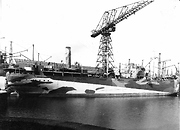 Created by unknown
Donated by Hartlepool Library Service
Created by unknown
Donated by Hartlepool Library ServiceA new build at Gray's resplendant in a disruptive dazzle paint scheme.
More detail » Dignitaries at launch
Dignitaries at launch
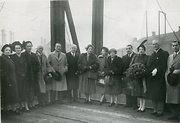 Donated by Hartlepool Museum Service
Donated by Hartlepool Museum ServicePart of the Shipbuilding collection
Dignitaries at the launch of a ship in Gray's yard.
More detail » Edith Essery in Red Cross uniform
Edith Essery in Red Cross uniform
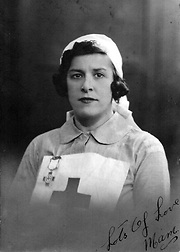 Created by unknown
Donated by Gillian Spokes
Created by unknown
Donated by Gillian SpokesEdith Essery worked at Gray's Shipyard as a nurse.
More detail » Evening function with Sir William Gray
Evening function with Sir William Gray
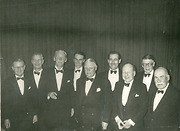 Donated by Hartlepool Museum Service
Donated by Hartlepool Museum ServicePart of the Shipbuilding collection
Evening function with Sir William Gary. It is not known what the occasion was though it must have been a company do as Mr Steward and Mr Douglas, Gray employees, are also in the picture. Mr Steward far left, Mr Douglas fourth from left with Sir William Gray fifth from left.
More detail » Fred Nichols - Painter
Fred Nichols - Painter
Four photogrpahs of Fred Nichols, a Painter at Gray's shipyard, who regularly painted ships' names, Plimsoll Line and draught markings on new vessels. These images were taken in 1960 when Fred was working on the Mabel Warwick.
More detail » Gray's Indentures, Agreements & other documents
Gray's Indentures, Agreements & other documents
A selection of Indentures, Aprentice Agreements, Testimonial letters and other documents relating to Gray's Shipyard and it's workforce.
More detail » Gray's Ship Plans
Gray's Ship Plans
Images of various ships plans and other documents relating to shipbuilding at the William Gray Shipyard.
More detail » Gray's Ships On the Stocks
Gray's Ships On the Stocks
Images of ships in various stages of construction at the William Gray Shipyard, including ship launches and vessels fitting-out.
More detail » Gray's Shipyard Assembly Area
Gray's Shipyard Assembly Area
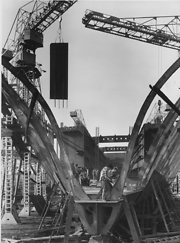 Created by Turners, Newcastle
Donated by Hartlepool Museum Service
Created by Turners, Newcastle
Donated by Hartlepool Museum ServicePart of the Robert Wood collection
Dated 1959
Men working on the structure of a vessel c1959
More detail » Gray's Workforce
Gray's Workforce
Images of the many people who worked in Gray's shipyard over the years.
More detail » Gray's Yards, Buildings, Boats and Vehicles
Gray's Yards, Buildings, Boats and Vehicles
A selection of images featuring the buildings, docks, workboats and vehicles at the William Gray Shipyard.
More detail » Gray's cricket team
Gray's cricket team
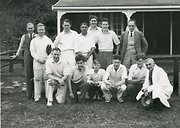 Donated by Hartlepool Museum Service
Donated by Hartlepool Museum ServicePart of the Shipbuilding collection
Gray's cricket team in front of a pavillion. Year and players not known.
More detail » Gray's cricket team
Gray's cricket team
 Donated by Hartlepool Museum Service
Donated by Hartlepool Museum ServicePart of the Shipbuilding collection
Gray's cricket team coming onto the pitch from the Oval Pavillion at Grayfields Sports Ground. Sir William Gray in front using a tie as a belt.
More detail » Irish Elm on the stocks
Irish Elm on the stocks
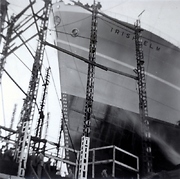 Donated by Mr. George McKie
Donated by Mr. George McKieDated 1953
A view of the Irish Elm, seemingly on launch day - July 29th, 1953.
More detail » Joining Ship - 1943
Joining Ship - 1943
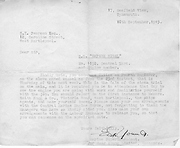 Donated by Mr. Steve Pearson
Donated by Mr. Steve PearsonDated 1943
Steve Pearson's letter to join the Gray-built ship Empire Nigel as Fourth Engineer, in September 1943.
More detail » Joseph Chapman Dalkin - Testimonial
Joseph Chapman Dalkin - Testimonial
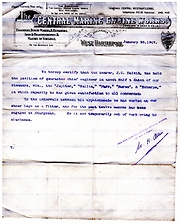 Donated by Mrs. Eileen Manners
Donated by Mrs. Eileen MannersDated 1907
A testimonial letter from CMEW relating to Joseph Dalkin's time as an Engineer with the company.
More detail » Keel under construction
Keel under construction
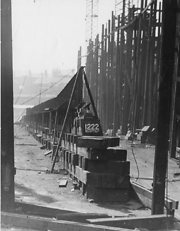 Donated by Hartlepool Museum Service
Donated by Hartlepool Museum ServicePart of the Shipbuilding collection
Keel under construction. Number 1222 which belonged to Irish Rose built in 1948.
More detail » Keith Watson - Apprenticeship Agreement
Keith Watson - Apprenticeship Agreement
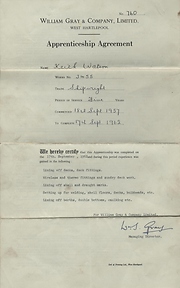 Created by W. Gray & Co.
Donated by Mr. K. Watson
Created by W. Gray & Co.
Donated by Mr. K. WatsonDated 1957
The front page of Keith Watson's Apprenticenship Agreement. As can be seen by the dates, Keith's completed his apprenticeship just as shipbuilding at Gray's was coming to an end.
More detail » Keith Watson - Apprenticeship Progress Report
Keith Watson - Apprenticeship Progress Report
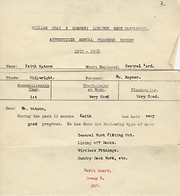 Created by W. Gray & Co.
Donated by Mr. K. Watson
Created by W. Gray & Co.
Donated by Mr. K. WatsonDated 1958
Keith Watson's first Annual Progress Report 1957/58 - and a very good one too.
More detail » Keith Watson - Reference
Keith Watson - Reference
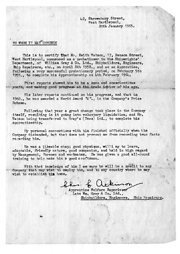 Donated by Shelley Watson
Donated by Shelley WatsonDated 1965
Character reference for Keith Watson who began his Apprenticeship at Wm. Gray's Shipbuilders on February 5th 1959, to be completed on 4th February 1964.
Donated by his daughter Shelley Watson who lives in Australia.
More detail » Launch of the Irish Cedar - 1948
Launch of the Irish Cedar - 1948
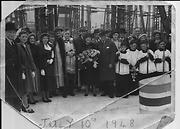 Created by Yeoman West Hartlepool
Donated by Josie Watts
Created by Yeoman West Hartlepool
Donated by Josie WattsDated 1948
Taken on July 10th 1948, this is almost certainly the launch of Irish Cedar which was 5627 gross tons and was built for Irish Shipping of Dublin.
At the ceremony are Sir William Gray and his wife (centre) and the priest is Father Francis Dunne of St Joseph's. The altar boys are from St Joseph's also and the second from the right is Jummy Cockerill.
As a note, a strange selection of hats is evident from a bowler, to an Edwardian creation on the right and a headscarf on the left, possibly reflecting the war and lack of availability of new clothing.
More detail » Letter to the Editor
Letter to the Editor
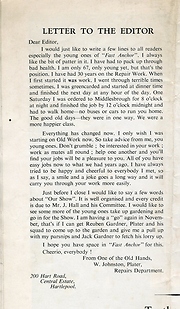 Donated by Mrs. Myra Docherty
Donated by Mrs. Myra DochertyDated 1957
A letter from William (Wilfred) Johnston to the Gray's shipyard house magazine 'Fast Anchor', after his retirement in 1957.
More detail » MV Avristan
MV Avristan
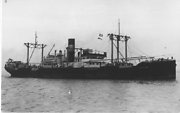 Created by Francis Elsdon
Donated by Hartlepool Museum Service
Created by Francis Elsdon
Donated by Hartlepool Museum ServicePart of the Elsdon Collection collection
MV Avristan. Gray built in 1923.
More detail » MV Boltonhall
MV Boltonhall
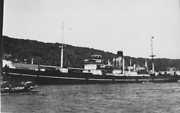 Created by Francis Elsdon
Donated by Hartlepool Museum Service
Created by Francis Elsdon
Donated by Hartlepool Museum ServicePart of the Elsdon Collection collection
MV Boltonhall built at Gray's Shipyard in 1935.
More detail » MV H Westfal Larsen
MV H Westfal Larsen
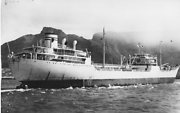 Created by Francis Elsdon
Donated by Hartlepool Museum Service
Created by Francis Elsdon
Donated by Hartlepool Museum ServicePart of the Elsdon Collection collection
Built 1930 in Copenhagen, owners Westfal-Larsen & Co. It was originally a tanker but was converted to a bulk carrier by Wm Gray's Yard and renamed Heranger. It was sold to Monaco in 1959 & renamed Saint Charles. Broken up in 1963.
More detail » MV Industria
MV Industria
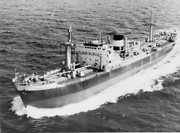 Donated by Hartlepool Museum Service
Donated by Hartlepool Museum ServicePart of the Elsdon collection
MV Industria at sea. Built in Gray's Yard in 1940.
More detail » MV Lindenhall
MV Lindenhall
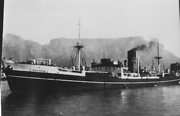 Created by Francis Elsdon
Donated by Hartlepool Museum Service
Created by Francis Elsdon
Donated by Hartlepool Museum ServicePart of the Elsdon Collection collection
MV Lindenhall built at Gray's Shipyard in 1937.
More detail » Mabel Warwick (5)
Mabel Warwick (5)
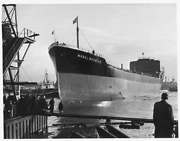 Donated by Douglas Ferriday
Donated by Douglas FerridayPart of the Hartlepool Library Services collection
Possibly the launch of the Mabel Warwick at Grays Shipyard, Hartlepool in 1960
More detail » Memories of the William Gray Shipyard and CMEW
Memories of the William Gray Shipyard and CMEW
MEMORIES OF THE Wm. GRAY SHIPYARDS & CENTRAL MARINE ENGINE WORKS.
by Derek Hinds.
My earliest memories of shipping was when I was around five years old, when my father, who worked in the Wm. Gray shipyards as a charge-hand lathe turner, at their Graythorp ship-repair centre, took me to see a ship launched. The date was 8th July 1948 and the ship was the IRISH CEDAR, (No.1219), a 5,627grt. general cargo ship being built by the Gray yards for the Irish Shipping Company, from Dublin, Ireland. She was completed in February 1949. Re-named:- MUSTANSIR in 1959, and was broken up at Karachi from 15th January 1971.
There was a spell of seven years before I watched the next ship launched. That was on 21st July 1955, at the Central Yard, when the bulk iron ore carrier OREGIS, (No.1272), 6,858grt, was being built for Houlder Brothers Ore Carriers Ltd. She was completed in November 1955. In 1972 she was converted into an RV-DSS. There was some excitement on the River Tyne as she was sailing following her conversion, she ran aground adjacent to the Black Middens rocks near to the river mouth. She was refloated and repaired. Re-named:- 1974 - HTS COUPLER 1; 1975 – OREGIS. She was broken up at Vigo from February 1983.
It was whilst I was at secondary school that I became more interested in ships and shipping. During our lunch break myself and a classmate used to cycle down to the docks to see what shipping was in port. At the secondary school we could see the shipyards from the upstairs classroom windows. The approaching time for a launch was when the ship’s hull was painted in its future owning companies colours, and a lot of the clutter of staging etc. was taken down. Over the next two years I witnessed nearly every launch from the Wm Gray yards.
They were: -s.s ANATOLIAN (No.1281) – Launched:- 21st June 1955, from the Dock Yard. Completed:- November 1955, for Ellerman Papayanni Ltd., 3,799grt. Re-named:- 1963 – CITY OF DURHAM; 1964 – ANATOLIAN; 1966 – ASCANIA; 1966 – ANATOLIAN; 1968 – ASCANIA; 1968 – ANATOLIAN; 1968 – AGIA SOPHIA; 1971 – FULKA; 1973 – KHALID; 1975 – GULF UNITY. B/U:- at Gadani Beach, 19th Feb.1978.
s.s LANCASTRIAN (No.1282) – Launched:- 14th October 1955,from the Dock Yard. Completed:- February 1956 for Ellerman Papayanni Ltd., 3,799grt. Re-named:- 1962 – CITY OF LEICESTER; 1964 – LANCASTRIAN; 1966 – ALSATIA; 1966 – LANCASTRIAN; 1969 – THEOKRATES; 1974 – KHORFAKAN. Wrecked:- 12th February 1975 on Sharjah Jetty.
m.v PEARL STONE (No.1274) – Launched:- 31st October 1955, from the Central Yard. Completed:- March 1956 for N.G. Livanos Co., Greece. 8,001grt. Re-named:- 1969 – TARPON SURF; 1974 – CHRISTOS. B/U:- at Gadani Beach, 18th August 1977.
m.v LOTTINGE (No.1280) – Launched:- 30th January 1956, from the Dock Yard.
Completed:- July 1956, for Constants Ltd. 4,215grt. Re-named:- 1974 – SAMANTHA M; 1975 – CUNSKI; 1991 – SHAHINAZ. B/U:- Alang, 23rd January 1992.
m.v ORMINA (No.1273) – Launched:- 28th February 1956, from the Central Yard.
Completed:- May 1956 for Houlder Bros. Ore Carriers Ltd. 6,858grt. Re-named:- 1974 – GENERALE FEDERICO. B/U:- at Vado Ligure, 16th April 1986.
m.v IRISH LARCH (No.1275) – Launched:- 11th June 1956, from the Central Yard. Completed:- October 1956 for Irish Sjipping Ltd. 8,283grt. Re-named:- ALIAKMON PROGRESS. B/U:- Inchon, 28th November 1979.
m.v IRISH MAPLE (No.1276) – Launched:- 3rd October 1956, from the Central Yard. Completed:- February 1957 for Irish Shipping Ltd. 8,288grt. Re-named:- 1968 – ALIAKNON PIONEER; 1979 – ANNOOR. B/U:- Gadani Beach, 2nd March 1982.
s.s CASTLEDORE (No.1284) – Launched:- 20th October 1956, from the Dock Yard. Completed:- December 1956, for Michalinos & Co. Ltd. 7,952grt. B/U:- Suao, 20th July 1974.
m.v PEARL SEA (No.1283) – Launched:- 19th December 1956, from the Central Yard. Completed:- April 1957, for N.G. Livanos Co., Greece. 7,977grt. Re-named:- 1969 – TARPON SEA; 1975 – DAPO SEA. Fire at Sitra Anchorage, Bahrain 1st June 1977. B/U:- Gadani Beach, 29th October 1977.
s.s LUCY (No.1285) – Launched:- 1st February 1957, from the Dock Yard. Completed:- May 1957, for N.G. Livanos Co., Greece. 7,583grt. Re-named:- 1973 – LEONIDAS MICHALOS; 1980 – BLESSING FIVE. B/U:- Visakhapatnam, 30th March 1981. Her steam plant was removed by her builders in 1961, and a diesel engine was then installed.
m.v IRISH ALDER (No.1286) – Launched:- 30th May 1957, from the Central Yard.
Completed:- September 1957 for Irish Shipping Ltd. 8,226grt. Re-named:- 1971 – ALIAKMON PILOT; 1977 – ATTICAN UNITY. Fire & beached Flushing Roads, 25th September 1977. B/U:- Bremen, 22nd March 1978.
s.s ROSE OF LANCASTER (No.1290) – Launched:- 29th July 1957, from the Dock Yard. Completed:- December 1957, for Guinea Gulf Lines. 5,197grt. Re-named:- 1965 – BOCNA. Fire at Matadi, Zaire, 24th December 1977. B/U:- Split, 23rd March 1978. This ship was fitted with a steam turbine for its main engine.
m.v IRISH ASH (No.1287) – Launched:- 24th September 1957, from the Central Yard. Completed:- January 1958, for Irish Shipping Ltd. 8,269grt. Re-named:- ALIAKMON POWER. B/U:- Ulsan, 20th June 1979.
m.v PEARL BEACH (No.1288) – Launched:- 12th December 1957, from the Central Yard. Completed:- April 1958 for N.G. Livanos, Co., Greece. 8,692grt. Re-named:- TARPON SWIFT; 1977 – TAPROBANE GOODRICH. B/U:- Kaohsiung, 27th August 1979.
m.v LORADORE (No.1291) – Launched:- 6th February 1958, from the Dock Yard.
Completed:- June 1958, for Constants Ltd. 8,077grt. Re-named:- 1966 – ALIARTOS; 1970 – THOMAS A; 1975 – IRENES BANNER. Fire at Dawes Is. Anchorage, Bonny River, 19th January 1978, & Beached.
m.v PEARL CREEK (No.1289) – Launched:- 19th May 1958, from the Central Yard. Completed:- September 1958, for N.G. Livanos, Co., Greece. 8,692grt. Re-named:- 1974 – LEODAMAS; 1978 – ZINOVIA. Wrecked:- 24th September 1979. B/U:- Gadani Beach, 3rd December 1980.
I left school at 15, and, as I was still interested in shipping, it was natural that I followed my Father into the shipyards. I started work as the ‘General Store Boy’ at the Central Marine Engine Works, of the Wm. Gray & Co. shipyards, of West Hartlepool. Running errands and issuing stores as required. I also learnt some of the tradesmen tricks like:- ‘Go to the store for a long stand,’ (which we duly obliged with, until the person asked why we weren’t serving him, when we said ‘well! you requested a long stand’). or ‘Go for a capful of nail holes,’ (for a joiner or carpenter) or ‘Go for a bucket full of steam to test this ------ .’ etc. etc. I also learnt from other people’s mistakes, like measuring up for bolts and forgetting to allow for the nut and possible washer(s), which was a regular occurrence.
During my time in the General Store I assisted with the engineering stores for the following ships which were being built in the yards:-
m.v CLEVELAND (No.1293) – Launched:- 31st July 1958, from the Central Yard. Completed:- November 1958, for Stephenson, Clark Ltd. 8,619grt. Re-named:- 1964 – VENICE; 1978 – HONG QI 131. Deleted:- 2002.
m.v RIVERDORE (No.1294) – Launched:- 30th September 1958, from the Dock Yard. Completed:- March 1959, for Constants Ltd. 8,080grt. Re-named:- 1974 – SHAH-E-RAZA; 1975 – AL KARIM; 1978 – BACHDANG; 1980 – EASTERN CONQUEST. B/U:- Gadani Beach, 8th March 1982.
m.v DEGEMA (No.1295) – Launched:- 27th November 1958, from the Central Yard. Completed:- April 1959, for Elder Dempster Lines. 8,138grt. Re-named:- 1979 – VEEJUMBO; 1982 – DEGEMA. B/U:- Gadani Beach, 30th January 1983.
m.v DIXCOVE (No.1296) – Launched:- 25th March 1959, from the Central Yard. Completed:- June 1959, for Elder Dempster Lines. 8,138grt. Re-named:- 1979 – GULF EAGLE. B/U:- Chittagong, 15th June 1983.
s.s MARY HOLT (No.1300) – Launched:- 21st May 1959, from the Dock Yard. Completed:- October 1959, for Guinea Gulf Line. 5,577grt. Re-named:- 1965 – SIPSAH. B/U:- Gadani Beach, 1st February 1975.
This ship was fitted with a steam turbine for its main engine. It was also the last steam turbine to be built by Gray’s in the Central Marine Engine Works.
m.v PEARL HAVEN (No.1292) – Launched:- 5th October 1959, from the Dock Yard. Completed:- January 1960, for N.G. Livanos, Co., Greece. 8,693grt. Re-named:- 1968 – THETIS; 1973 – EVANGELISMOS; 1975 – ANGLIA; 1976 – CHIOS. B/U:- Kaohsiung, 4th October 1979. This was the last ship to be launched from the Dock Yard slipways.
After a spell of nearly a year in the General Store, it was time for me to move into the Engine Works to start serving my apprenticeship as an engineer. I started on light machining, turret lathes, drilling, milling and slotting. Marking off castings, and materials before they went for machining. Following a spell of working on boiler fittings I was moved into the Offices doing progress and planning, until the demise of the engine works. With people leaving at this time, taking up new jobs elsewhere, I was moved back out of the offices to marking off, as I was one of the last apprentices with that experience.
Whilst I was serving my apprenticeship the other ships that were built and completed by the Gray’s yard were:-
m.v MABEL WARWICK (No.1301) – Launched:- 14th February 1960, from the Central Yard. Completed:- June 1960, for Houlder Bros., Ore Carriers Ltd. 11,632grt. Re-named:- 1976 – NIKOLAS MALEFAKIS; 1980 – RUBINI. B/U:- Eleusis, 8th June 1983, following engine damage 10th -14th July 1982.
m.v IRISH SYCAMORE (No.1302) – Launched:- 17th January 1961, from the Central Yard. Completed:- May 1961, for Irish Shipping Co. 10,560grt. Re-named:- 1973 – MARIA; 1978 – ELIANE; 1980 – MALDIVE NOBLE. B/U:- Alang, 7th April 1984.
m.v JOYA McCANCE (No.1307) – Launched:- 11th July 1960, from the Central Yard. Completed:- October 1960, for Houlder Bros., Ore Carriers Ltd. 11,871grt. Re-named:- 1966 – ST MARGARET; 1978 – HADIOTIS; 1987 – MARITIMA VI (Barge). Stranded:- River Orinoco, 12th July 1985. B/U:- Turkey, 1989 / 90.
m.v BLANCHLAND (No.1303) – Launched:- 29th June 1961, from the Central Yard. Completed:- November 1961, for Stephenson, Clark Ltd. 8,999grt. Re-named:- 1968 – EUGENIA M; 1982 – IONION PRINCESS. B/U:- Qinhuangdao, January 1986. Damaged by an explosion, August 1985.
The BLANCHLAND was the last ship to be built by the Wm. Gray shipyard and the Central Marine Engine Works at West Hartlepool. The company ceased trading a year or so after the last ship sailed away.
It was during my lunch breaks that I first became aware of the Ben Line and their ships. (This was the company which I later joined, and sailed, for a few years, on some of their steamships.) Sitting on the quayside one day, I watched first, the BENARTY, a heavy lift vessel, of 7,795grt, sail from Hartlepool, to be replaced in port the next day by the BENLEDI,an identical sister ship. She remained in the port for a few years until she in turn was replaced by another similar sister ship the BENALBANACH.
The BENARTY was built in 1945 as the EMPIRE WALLACE, joining Ben Line in 1956. Sold in 1962 she was renamed ELYS HARBOUR, over the next few years she was renamed UNIQUE DEVELOPER; FERMENCO; AVALON and BAHIA COLOMBIA. She was broken up at Chittagong in 1988.
BENLEDI was also built in 1945 as the EMPIRE ADMIRAL, renamed PETER DAL, before she joined Ben Line in 1951. She was sold in 1963 and was renamed ANDROS TOMENNO later to become UNIQUE CARRIER before she was broken up at Kaohsiung, Taiwan, in 1969.
BENALBANACH was built in 1946 as the EMPIRE ATHELSTAN, Ben Line acquired her in1947. She was sold in 1966 to the Ministry of Transport and was renamed CAMELOT. In 1969 she was again sold and was renamed DRAGON CASTLE. Following another sale she finally arrived for breaking up at Split, Yugoslavia in 1975.
I was later to learn, when I joined the Ben Line, that the vessels in Hartlepool were on a Government Charter, which meant one of the vessels had to be in a U.K. port at all times in case the need arose to transport heavy military equipment by sea. The ships, whilst in port, were manned by a skeleton crew who kept them in a working condition, in readiness in case they were needed.
Just before the final closure of the Gray’s Shipbuilding Yards, I was transferred to the J. Readheads shipyard and engine works at South Shields, on Tyneside, were I spent eighteen months, until I had completed my apprenticeship.
More detail » Peter Stevens - Apprenticeship 1958 (1)
Peter Stevens - Apprenticeship 1958 (1)
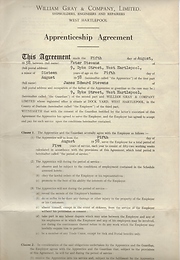 Donated by Mr. Peter Stevens
Donated by Mr. Peter StevensPeter Stevens' Apprenticeship Agreement.
More detail » Peter Stevens - Apprenticeship 1958 (2)
Peter Stevens - Apprenticeship 1958 (2)
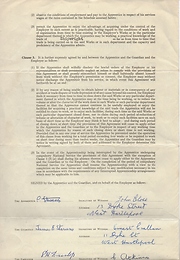 Donated by Mr. Peter Stevens
Donated by Mr. Peter StevensPeter Stevens' Apprenticeship Agreement.
More detail » Peter Stevens - Apprenticeship 1958 (3)
Peter Stevens - Apprenticeship 1958 (3)
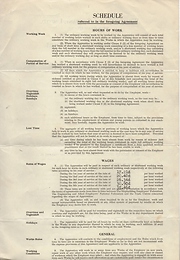 Donated by Mr. Peter Stevens
Donated by Mr. Peter StevensPeter Stevens' Apprenticeship Agreement.
More detail » Possible meeting between workers and management
Possible meeting between workers and management
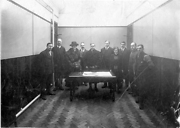 Donated by Hartlepool Museum Service
Donated by Hartlepool Museum ServicePart of the Shipbuilding collection
Possible meeting between workers and management. This picture seems to show some workers with a team of managers or owners. Possibly Grays.
More detail » Presentation for a Gray's employee
Presentation for a Gray's employee
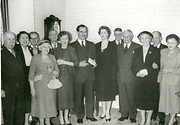 Donated by Hartlepool Museum Service
Donated by Hartlepool Museum ServicePart of the Shipbuilding collection
Presentation for a Gray's employee. The presentation appears to have been for a Mr Douglas. Sir William Gray and Mr Steward are also in the picture.
More detail » Recollections of a trip on the "Joya McCance" in 1960
Recollections of a trip on the "Joya McCance" in 1960
I just did the one trip on the Joya Mc Cance , signing off in Immingham on the 10th December, 1960 along with the rest of the Hartlepool crew. I wished I had not as I was offered my rating as Assistant Steward by the captain when he was doing his inspection one week end.
He said he would see the Chief Steward about it. I told him that I wanted to get more experience on other ships, but really I did not want to take that step yet (foolish lad). I did not keep a dairy or take pictures of the trip, anyway I didn't have a camera. The trip was great. I was a lad of sixteen and had not been away from home apart from my time at Gravesend Sea School, and the sights and the scenery around me was something taken from a film. Once I got over the sea sickness and the routine of the job I was starting to enjoy the trip. I was working most of the time in the pantry at meal times, then cleaning the Engineer’s quarters, making the bunk- beds , scrubbing the deck in the alleyways and any other jobs that needed going , but I still found time to go on deck to see the sights when time allowed me to. I wished my mates at home could have been with me and seen what I was seeing because I could not have been able to describe it to them.
The sea, sun, sight, and smell of the land what an experience! I did get my photo taken a few times by one of the Assistant Stewards on board the ship. He said that he was going to get them developed and give me them, but that was all forgotten when we signed off the ship and he never ever sent them on to me. The only crew I remember well are Kenny Kay, Assistant Steward; Dave Horsley, Ordinary Seaman; and little Jacky Horsley, Able Seaman, who took me ashore and looked after me. Great days.
Paddy Riley.
More detail » SS Garbetta
SS Garbetta
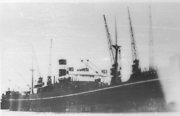 Donated by Hartlepool Museum Service
Donated by Hartlepool Museum ServicePart of the Elsdon collection
SS Garbetta. Built in Grays Yard in 1920.
More detail » SS Irish Plane
SS Irish Plane
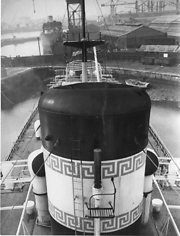 Donated by Hartlepool Museum Service
Donated by Hartlepool Museum ServicePart of the Shipbuilding collection
SS Irish Plane, under the CMEW crane, taken from the Atlantic Express whilst being fitted out.
More detail » SS Lucy
SS Lucy
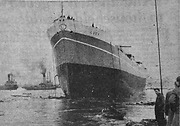 Created by NDM
Donated by Hartlepool Museum Service
Created by NDM
Donated by Hartlepool Museum ServiceDated 1957
Lucy was 11,400 tons and was built by Gray's for the Greek shipowner NG Livanos. It was launched 24 hours late as there were very high winds at the proposed time. The image shows tugs manoeuvring her into position after the launch.
More detail » Ship launch in the 1950s
Ship launch in the 1950s
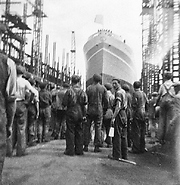 Donated by Mr. George McKie
Donated by Mr. George McKieDated 1952
A slighty out of focus photograph of a ship launch at the William Gray yard. The "L" on the bow of the ship shows her to be owned by G. Livanos, and is possibly the Evgenia, launched on July 7th, 1952.
More detail » Shipwright Apprenticeship document (2)
Shipwright Apprenticeship document (2)
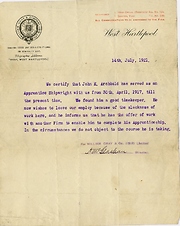 Donated by Mr. Alan Archbold
Donated by Mr. Alan ArchboldDated 1921
A document from William Gray & Co. certifying that John Edward Archbold had successfully served his Shipwright Apprenticeship at the yard between 1917 - 1921.
More detail » Sir William Gray and Mr Douglas
Sir William Gray and Mr Douglas
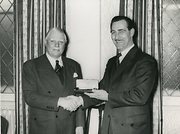 Donated by Hartlepool Museum Service
Donated by Hartlepool Museum ServicePart of the Shipbuilding collection
Sir William Gray presenting Mr Douglas with a boxed pipe set. Occasion not known.
More detail » Sir William Gray with Mr Steward
Sir William Gray with Mr Steward
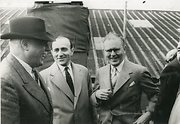 Donated by Hartlepool Museum Service
Donated by Hartlepool Museum ServicePart of the Shipbuilding collection
Sir William Gray with Mr Steward presumably outside the works.
More detail » Union Card for an Apprentice in the 1950s (1)
Union Card for an Apprentice in the 1950s (1)
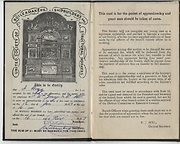 Donated by Mr. A. Hogg
Donated by Mr. A. HoggDated 1957
The inside cover of Mr. A. Hogg's Union 'card' dated 1957.
More detail » Union Card for an Apprentice in the 1950s (2)
Union Card for an Apprentice in the 1950s (2)
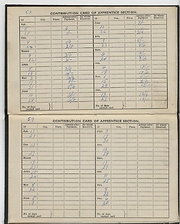 Donated by Mr. A. Hogg
Donated by Mr. A. HoggDated 1957
Some of the inside pages of Mr. A Hogg's Union 'card', showing payments were made fortnightly.
More detail » Unknown ship in Gray's stocks
Unknown ship in Gray's stocks
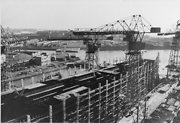 Donated by Hartlepool Museum Service
Donated by Hartlepool Museum ServicePart of the Shipbuilding collection
Ship in stocks in the Central Yard, Hartlepool.
More detail » View of Central Shipyard
View of Central Shipyard
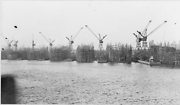 Donated by Hartlepool Museum Service
Donated by Hartlepool Museum ServicePart of the Shipbuilding collection
View of Central Shipyard from Central Dock. It shows eight ships in stocks.
More detail » Wingfield Castle before restoration
Wingfield Castle before restoration
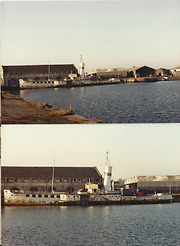 Created by Bill Henderson
Donated by Bill Henderson
Created by Bill Henderson
Donated by Bill HendersonDated 1986
Built in Hartlepool by William Gray in 1934, PSS Wingfield Castle was a paddle steamer used to cross the Humber until 1974. She was then bought by Whitbread to be used as a floating pub in Swansea. However this never happened and in June 1986, she came back 'home' to Jackson Dock in Hartlepool to be restored.
This photo was taken before restoration and the new Museum of Hartlepool was still to be built on the nearby quayside. Some of Gray's old buildings are still to be seen.
More detail » Wm Gray & Co - Mr & Mrs Steward
Wm Gray & Co - Mr & Mrs Steward
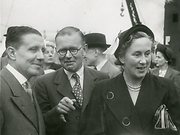 Donated by Hartlepool Museum Service
Donated by Hartlepool Museum ServicePart of the Shipbuilding collection
Wm Gray & Co - Mr & Mrs Steward at launch.
More detail » Wm Gray & Co - Mr & Mrs Steward
Wm Gray & Co - Mr & Mrs Steward
 Donated by Hartlepool Museum Service
Donated by Hartlepool Museum ServicePart of the Shipbuilding collection
Wm Gray & Co - Mr & Mrs Steward strolling with other people.
More detail » Wm Gray & Co. - Mr & Mrs Steward
Wm Gray & Co. - Mr & Mrs Steward
 Donated by Hartlepool Museum Service
Donated by Hartlepool Museum ServicePart of the Shipbuilding collection
Wm Gray & Co. - Mr & Mrs Steward. It is not known what the occasion was.
More detail »




